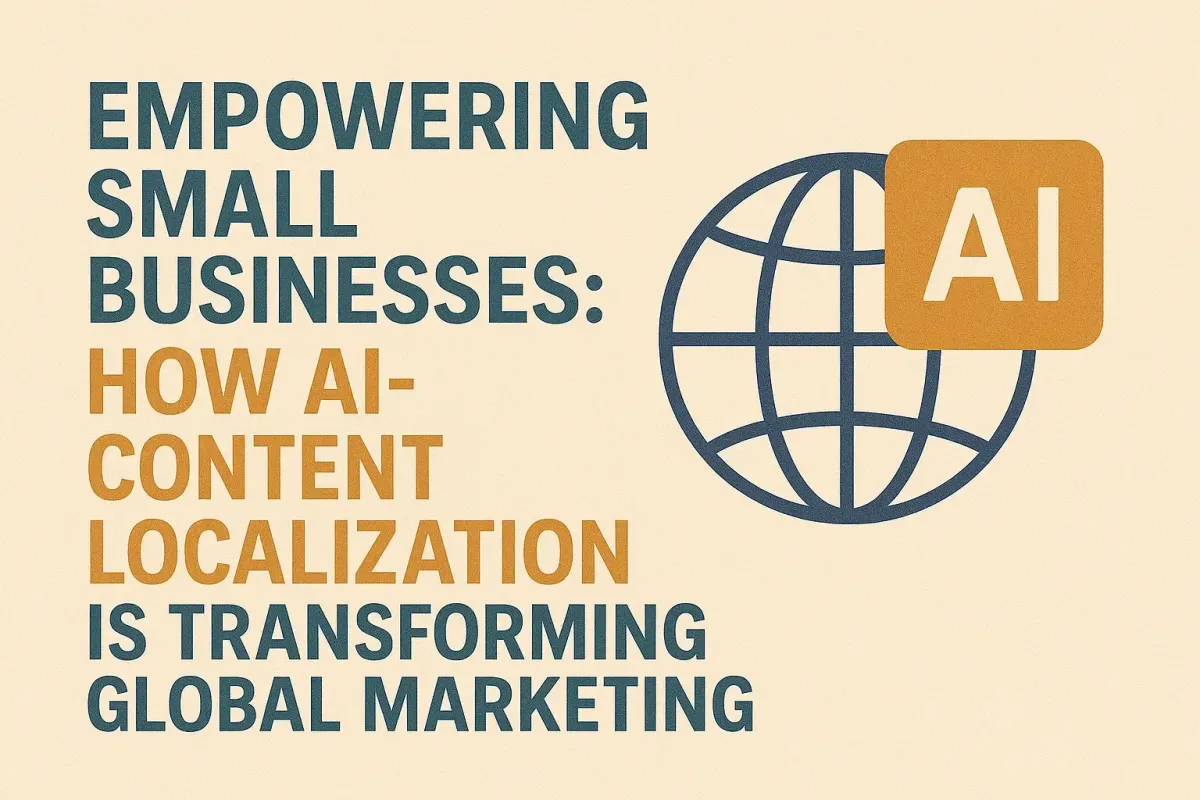
Empowering Small Businesses: How AI-Powered Content Localization is Transforming Global Marketing
Empowering Small Businesses: How AI-Powered Content Localization is Transforming Global Marketing
For years, small businesses battling to establish a foothold in the global marketplace faced a daunting challenge: how to effectively communicate with audiences in diverse cultures, languages, and regions—all while keeping costs manageable. Enter AI-powered content localization, a game-changing tool that’s rewriting the rules of global marketing for small businesses.
If you’re a small business owner looking to expand your horizons without blowing your budget, this article will illuminate how leveraging artificial intelligence can help you break language barriers, resonate with international audiences, and amplify your brand across borders. Here’s how AI is transforming marketing strategies—and how you can ride the wave.

The Global Marketing Challenge for Small Businesses
The internet has leveled the playing field, enabling small businesses to compete with big players like never before. But with opportunity comes complexity. Reaching a global audience means adjusting your message to suit different languages, customs, and cultural nuances.
This is where most businesses hit a wall—and for good reason. Traditional content localization, involving human translators and manual workflows, is often expensive and time-consuming. For small businesses, it’s simply not feasible to create individualized campaigns for each target market.
Enter AI-powered content localization: a solution at the intersection of technology, creativity, and efficiency.
What is AI-Powered Content Localization?
At its core, AI-powered content localization involves using artificial intelligence to adapt your content—be it website copy, product descriptions, emails, videos, or social media posts—for specific regions, languages, or cultures.
Imagine this: You want to market a product in Spain, Brazil, and Japan. Instead of hiring separate translators and copywriters for each region, an AI tool analyzes your existing content and transforms it into contextually accurate, culturally relevant messaging for each target market.
Using machine learning, neural networks, and natural language processing (NLP), AI tools like [DeepL Translator](https://www.deepl.com/translator), [Smartling](https://www.smartling.com/), or [Unbabel](https://unbabel.com/) do more than just translate— they adapt. This means understanding idioms, adjusting tone, and even accounting for regional dialects.
Why AI Localization is a Game-Changer for Small Businesses
Here’s how AI is leveling the playing field:
1. Cost Efficiency
Traditional localization involves paying human experts like linguists, translators, and cultural consultants. This can cost thousands of dollars per campaign. AI-powered tools slash these expenses by automating the bulk of the process while still maintaining accuracy and quality.
For instance, small businesses using AI platforms like [Phrase](https://phrase.com/) report up to 40% savings in localization budgets.
2. Speed to Market
The global marketplace moves at the speed of a meme. AI streamlines localization workflows, enabling businesses to launch multi-region campaigns in days rather than weeks. This agility is a lifesaver during product launches, holiday promotions, or time-sensitive events.
Platforms like [Lokalise](https://lokalise.com/) even allow businesses to localize in real-time, ideal for eCommerce sites updating inventory across countries.
3. Improved Customer Experience
Localization isn’t just about translation—it’s about relevance. AI tools use sentiment analysis and audience data to ensure your message resonates emotionally and culturally with your audience.
For example, adapting a holiday campaign for South Korea might call for a completely different tone, imagery, and messaging—something an AI like [Memsource](https://www.memsource.com/) can handle seamlessly.
This cultural alignment fosters trust with your customers, increasing conversion rates and long-term loyalty.
4. Scalability
Planning to expand from one international market to five? AI-powered localization easily scales with your business. Tools like [Transifex](https://www.transifex.com/) or [Crowdin](https://crowdin.com/) are built to manage the complexities of multi-market campaigns with ease.
You don’t need to reinvent the wheel with each new region—you just need the right data and an AI localization tool by your side.
AI in Marketing Strategies: Practical Applications
Small businesses are already leveraging these tools in innovative ways. Here’s how you can incorporate AI-powered content localization into your marketing strategy:
1. Website Localization
Your website is your global storefront. Using AI, you can create localized versions of your site tailored to each region—down to currency, shipping details, and even SEO keywords.
For instance, platforms like [Weglot](https://weglot.com/) specialize in making websites multi-lingual, helping businesses rank higher on search engines in local markets.
2. Social Media Customization
Gone are the days of one-size-fits-all social media posts. AI tools like [ChatGPT](https://openai.com/chatgpt) can adapt your captions, hashtags, and even imagery for global audiences. This ensures your content stays culturally appropriate and relevant.
3. Localized Email Campaigns
Email marketing sees higher open rates when messages feel personal and localized. AI tools like [Persado](https://www.persado.com/) or [Phrasee](https://phrasee.co/) help you craft culturally resonant email campaigns, increasing click-through rates and engagement.
4. Video Subtitles and Dubbing
Video content is king, but making videos accessible across languages can be a nightmare. Tools like [Descript](https://www.descript.com/) or [Rev](https://www.rev.com/) automate the creation of subtitles and dubbing, ensuring your message transcends linguistic barriers.
Real-World Success Stories
Take Soko Glam, a U.S.-based Korean beauty eCommerce brand, as an example. By using AI localization tools for content translation and audience targeting, they increased their international customer base by 30% in under a year.
Another case study is Shopify, whose merchants utilize AI-powered localization to translate product descriptions and optimize international SEO, driving millions in added revenue. Learn more about international SEO strategies from resources like [Moz](https://moz.com/beginners-guide-to-international-seo).
Even small family-owned brands like Monteverde Olive Oil have used localized AI-powered marketing campaigns to grow their European sales by 22%, proving that these tools aren’t just for tech giants.
Embrace the Future of Global Marketing
Let’s face it: in today’s world, staying local simply isn’t an option. The global marketplace is calling, and small businesses equipped with AI-powered content localization are answering with confidence.
AI isn’t just an expense—it’s an investment that brings high ROI through increased market reach, better customer relationships, and exponential growth.
Ready to take your business global? Start experimenting with AI tools today, or reach out to a localization service provider that leverages these technologies. Aligning with platforms like [Creative Copyz](https://creativecopyz.com) for guidance can help you navigate the roadmap of international success.
Because when it comes to global growth, the size of your business doesn’t matter—the size of your ambition does.
Ready to harness the power of AI?
Book a call today to learn how we can implement these strategies for your business:

